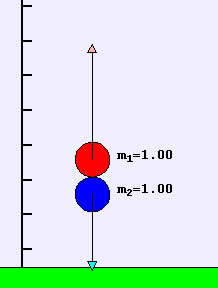

We study ODE models and show how they can be used to detect hard disk collisions in models such as the ideal gas and Newton's cradle. We also introduce discrete maps and Poincare sections.
The Two Ball Bounce Map Model extends the Two Ball Bounce Model by adding a Poincare map to the simulation. As in the previous model two balls are constrained to move in one dimension above a floor in a constant gravitational field with g=1.
Except for the instants when collisions occur, the Hamiltonian (energy) of a two ball system is a simple sum of kinetic and gravitational potential energies.

where p is a linear momentum, y is a height, and g is the acceleration of gravity. The balls have unit diameter and the potential energy reference value has been chosen so that the total energy is zero if the balls are at rest on top of one another. The dynamical properties of this system depend critically on the ratio of the two masses r=m1/m2 and we use this ratio as the model's control parameter and vary it using a slider. Note that the model sets the smaller mass to one so that the other mass will be greater than or equal to one.
A useful Poincare map for this problem displays the velocity v1 and height y1 of the upper ball m1 at each instant that the lower ball m2 hits the floor. In order to compare Poincare maps with different mass ratios, it is useful to plot scaled position y and velocity v values of these quantities. These scaled position are

where E is the total mechanical energy and M is the total mass (m1+m2).
Exercise: Click within the Poincare map to set the initial state of the system. How many attractors can you find if the default mass ratio r=6? Explain the physical reason for the attractor at y1 ~0.63 and v1=0.
The following models use ODE events to detect collisions between hard objects (disks or spheres).
The following models explore iterative maps:
The following dynamical systems are investigated using Poincare maps:
Additional models may be be posted for self-study.
The Two Ball Bounce Map Model was created by Wolfgang Christian using the Easy Java Simulations (EJS) version 4.1 authoring and modeling tool. You can examine and modify a compiled EJS model if you run the model (double click on the model's jar file), right-click within a plot, and select "Open Ejs Model" from the pop-up menu. You must, of course, have EJS installed on your computer.
Information about Ejs is available at: <http://www.um.es/fem/Ejs/> and in the OSP comPADRE collection <http://www.compadre.org/OSP/>.